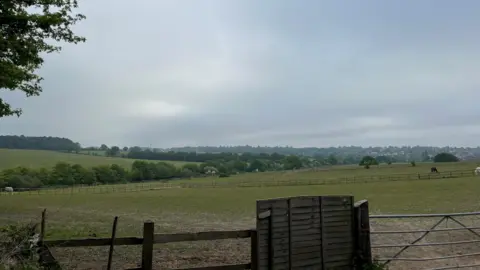**London Mayor Proposes Exploration of Green Belt Development to Address Housing Crisis**
In a significant policy shift, Sir Sadiq Khan, the Mayor of London, has proposed to “actively explore” the potential for building on some of London’s green belt land. This move aims to tackle the city’s ongoing housing crisis, which has left many residents struggling to find affordable accommodation. The Mayor’s announcement is expected to be made during a speech in Greenwich, where he will argue that the current status quo regarding land use is “wrong, out-of-date, and unsustainable.”
Under the new proposals, city planners will consider releasing certain areas of green belt land for development, provided that developments adhere to specific criteria. These include the availability of affordable housing, energy efficiency measures, accessibility to transport links, and ensuring access to green spaces. Susan Hall, the leader of the Conservative group at City Hall, has criticized the Mayor’s initiative, suggesting that it prioritizes the interests of the Labour party over the preservation of London’s precious green spaces.
This latest development marks a notable departure for Sir Sadiq Khan, who had previously maintained that the green belt should be preserved while brownfield sites remained available for development. However, with a dramatic rise in housing demand—laying heavily on infrastructure and social resources—the Mayor seems set to argue that relying solely on brownfield development will not suffice to meet London’s needs. He is expected to announce a consultation focused on an updated London Plan, which will articulate a strategy for the capital’s development over the next twenty years.
**An Increasing Need for Housing**
The urgency for expanding housing availability in London is underscored by current statistics. The city has set a target to build 88,000 new homes each year, yet it is managing to deliver only around 40,000 annually. The rising rental prices, with an increase of 11.5% over the past year, and local councils spending approximately £4 million a day on temporary accommodations due to increasing homelessness, further highlight the predicament.
The recommendation for evaluating green belt land aligns with the government’s push for a review of low-quality parts of the green belt, often referred to as “grey belt” lands. The Mayor is anticipated to assert that many sections of the green belt are poorly maintained and provide limited public enjoyment, stating that only about 13% consists of accessible parks or areas. He will advocate for developments in thoughtfully selected areas of the green belt, claiming they could yield hundreds of thousands of high-quality homes for Londoners in need.
**Mixed Reactions from Leaders and Advocates**
While some local authorities and community leaders support the move, there is significant opposition. Claire Holland, chair of London Councils and leader of Lambeth Council, has backed the Mayor’s proposal, citing the critical housing pressures the city currently faces. Ben Twomey, from the campaign group Generation Rent, echoed the sentiment emphasizing the necessity of building homes, even within the green belt, as long as it is done appropriately.
Conversely, the countryside charity CPRE has come out against this initiative, arguing that building on green belt land is not a sustainable solution to the housing crisis. CPRE spokesperson Alice Roberts stressed the fact that there are already 300,000 homes approved for construction that remain unbuilt, suggesting that priority should be placed on these properties instead. Additionally, David Simmonds, the Conservative MP for Ruislip, Northwood and Pinner, condemned the initiative as a betrayal of the Mayor’s earlier commitments to protect the green belt.
**Looking Ahead**
Furthermore, this announcement arrives just a year before council elections in London, during which all 32 boroughs will hold votes, potentially heating up the political landscape regarding housing policy. BBC London’s political editor indicated that this proposal may incite conflict with several outer London Conservative boroughs that previously opted out of participating in the Mayor’s review of the green belt.
In conclusion, the Mayor’s new policy direction to explore the use of green belt areas for housing development is likely to spark robust debate among stakeholders, highlighting the complex balance between urban growth and environmental preservation in one of the world’s most densely populated cities. As opinions remain divided, the true impact on London’s housing crisis and the city’s green spaces will unfold in the deliberations ahead.



